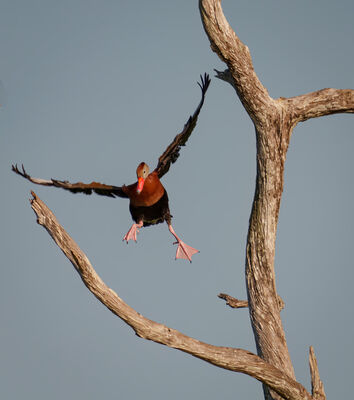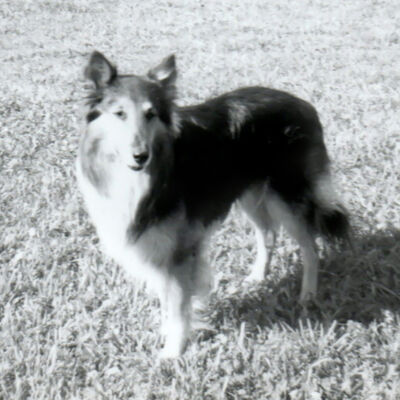What’s YOUR Post-processing Workflow?
Sep 27, 2022 16:09:27 #
bajadreamer wrote:
I am not sure this will post well on UHH. I have ... (show quote)
You can customize the FRV display for screen sharpening and auto exposure adjustments. Look at Sharpening under View and the options under Adjust when viewing a single image full-screen.
My attitude involves a few related ideas:
1, Your sharpest images are the only images to be kept and imported into LR for development work as possible keepers.
2, "Fast" RawView is for making "fast" culling decisions. Although the reject / delete decisions should be permanent in FRV, if you're unsure, bring the image into LR and make a more informed decision in LR after applying some Develop Module actions and building 1:1 previews for a detailed assessment. Similarly, if unsure in FRV pass-1, keep and compare with what is left after a pass-1 culling during in a pass-2.
3, Know your cameras and your software. I've learned that I don't need to be overly concerned about possibly soft looking RAW images in FRV. The ones that pass through culling get a lot better in LR, especially the Sony-camera RAW. The culled images via FRV are clearly inferior, even when the kept might seem "soft" in FRV. I continue to try to make 1-second decisions on an image in FRV. If I'm unsure, I keep, especially during the first pass that kicks all the obvious failures. This makes the 2nd pass more effective as I'm looking at only could-be-good vs obviously-good, where obviously-good is more obvious.
4, I mostly look at the images in FRV just at the 1:1 pixel level. I assume my composition is fine if the full-image is viewed. At this stage of culling, I only care about the pixel-level focus. I can kick composition issues / duplicates later, after the pixel-level details are confirmed or kicked as failing.
Sep 27, 2022 16:18:25 #
CHG_CANON wrote:
You can customize the FRV display for screen sharp... (show quote)
Thank you for the info on FRV. I will check that. I agree with your thoughts about assuming certain things about an image like composition, etc. However, that being said, PM still works quicker for me. When I go to 100% (also my usual view for culling), I can be assured that a sharp image is a sharp image. When I shoot bursts of BIF, not all the images in the burst will be equally sharp. Easy with PM to cull those. Not so easy with FRV if I have to bring them into LR or DPP to determine focus and sharpness.
I do not normally use LR. I convert with DXO Pure Raw, so from PM all my keepers go to DXO PR. From there, eventually they will go to PS for final processing. I like DXO PR color conversion and noise reduction better than I like ACR's.
Sep 27, 2022 16:23:54 #
bajadreamer wrote:
Thank you for the info on FRV. I will check that.... (show quote)
Whatever tool works best, from those you own. I described my process in an earlier reply. I use the LR compare process a lot when there are many seemingly great images and the details of FRV aren't enough to make a judgement. The 1:1 previews with the LR development settings applied in batch let me compare images side by side in LR, seeking the one or few that justifies any additional edit effort.
Sep 27, 2022 16:24:41 #
bajadreamer wrote:
I am not sure this will post well on UHH. I have ... (show quote)
On its website FRV states it does not read the embedded jpeg but decodes the actual raw data.
Sep 27, 2022 16:34:22 #
bkwaters wrote:
On its website FRV states it does not read the embedded jpeg but decodes the actual raw data.
I believe that is true. The histogram it posts is the RawDigger histogram, from the RAW data. Problem for me is the resolution. Paul suggested some changes I might make to the settings to improve that; I will try it, although it is somewhat moot now as I purchased Photo Mechanic long ago and have become accustomed to using that software.
Sep 27, 2022 19:24:03 #
I have a description of my Lightroom workflow here
I wrote that about 2016 and revised it in 2018. Before 2022 I was using a PC exclusively. Starting in 2022 I began to use a MacBook Pro. The intake program I used, Downloader Pro, does not work with Apple, so that part of my workflow has changed. I can import directly into LR from a card reader (or from the camera/USB) and change the name on import. I find LR a bit more cumbersome to work with and also, Downloader Pro would use the EXIF time to 0.01 second, useful to separate burst shots. LR only uses 1 second granularity in their naming. Since I like to have the increased time resolution in the file name, I wrote a Python program that emulates the way I used Downloader Pro (roughly).
I do all the culling in LR (described in the user file referenced above). I delete all the pure junk (OOF, photos of my foot, things like that*) but, being a lifelong card-carrying packrat, I tend to keep the unused files on my disk, although I delete them from the catalog. I have actually found occasion to use a few of them (probably too few to be really important)(and only after re-importing them to LR). Storage space is fairly cheap.
* I should say "...UNWANTED photos of my foot..."
Moreover, the advent of Topaz Sharpen AI has made possible the use of slightly OOF images, so that should be taken into account. However, I am perfectly capable of OOF images that are well past the limits of any AI to sharpen. It becomes a judgement call at cull-time.
I wrote that about 2016 and revised it in 2018. Before 2022 I was using a PC exclusively. Starting in 2022 I began to use a MacBook Pro. The intake program I used, Downloader Pro, does not work with Apple, so that part of my workflow has changed. I can import directly into LR from a card reader (or from the camera/USB) and change the name on import. I find LR a bit more cumbersome to work with and also, Downloader Pro would use the EXIF time to 0.01 second, useful to separate burst shots. LR only uses 1 second granularity in their naming. Since I like to have the increased time resolution in the file name, I wrote a Python program that emulates the way I used Downloader Pro (roughly).
I do all the culling in LR (described in the user file referenced above). I delete all the pure junk (OOF, photos of my foot, things like that*) but, being a lifelong card-carrying packrat, I tend to keep the unused files on my disk, although I delete them from the catalog. I have actually found occasion to use a few of them (probably too few to be really important)(and only after re-importing them to LR). Storage space is fairly cheap.
* I should say "...UNWANTED photos of my foot..."
Moreover, the advent of Topaz Sharpen AI has made possible the use of slightly OOF images, so that should be taken into account. However, I am perfectly capable of OOF images that are well past the limits of any AI to sharpen. It becomes a judgement call at cull-time.
Oct 3, 2022 11:33:38 #
bkwaters wrote:
I am curious as to others PP workflow. Currently I... (show quote)
I use ACDSee for my photo database. First I go though the pics and catalog them giving keywords to all the pictures. This is easy as can be with ACDSee as generally lots of pictures can be tagged at once, for example, Trip to Canada, can all be done at once, then pics with the wife in them can be selected and added to her keyword and so on.
Next, I cull out all the bad pics then decide what pics I might want to work on, and move them to a work folder, the rest all go in a group folder for all original jpgs. I never rename my original files as the camera's numerical name is perfect and is automatically unique and sorted by date taken. I keep all original jpg's original. Usually I guess I edit maybe 10% of my files, and save the edited files in various folders, and if a complicated edit, I save the development file (.PSD) in another separate folder. I don't rename the edited files either, other than perhaps append a letter to indicate what editor I used, or TV to indicate I resized it to fit on my HDTV (1920x1080) screens.
IF I've taken RAW photo's, I move them to a work folder for processing. Once processed, I convert them to JPGs as I have no need for a bunch of raw files, I can always further process the JPG as it should be as good as it gets and no need for further raw development, they will be close enough for further jpg processing if wanted.
For editing, ACDSee has a nice editor, easy and powerful, does layers and all that, but I rarely use it. ACDSee lets you select any editors to interface with ACDSee so I can load a picture into Affinity, or PS, or FastStone or IrfanView or whatever with a click. I generally stick with one editor, and for the past few years, that's been Affinity Photo. Rarely see a reason to use a lightweight editor particularly one w/o layers. An editor can't have too many functions, just too few. Affinity, PS and ACDSee seem to have them all, so why choose a lessor editor?
My new Iphone 13 names files Img_0001, Img_0002 and so on, so now I have to rename those files as IP_0001, IP_0002 so they don't get mixed up with my kids pictures who also have IPhones with the same naming convention. ACDSee makes that super easy as well.
Anyway, ACDSee has been my Photo manager since the early 1990's, it is up to the task for the center of all my photo tasks and makes photo management fun and very worthwhile effort. It does it all, so it has a learning curve. Not for everyone.
Oct 3, 2022 11:48:59 #
Oct 3, 2022 16:33:45 #
BigDaddy wrote:
I use ACDSee for my photo database. First I go tho... (show quote)
I have been using ACDSee for years and like it a lot. I am so conflicted about whether to save or discard the original RAW files. I need a software psychologist.
Oct 3, 2022 16:55:14 #
bkwaters wrote:
I have been using ACDSee for years and like it a lot. I am so conflicted about whether to save or discard the original RAW files. I need a software psychologist.
Save them.
Storage is cheap.
You will need them if you decide to re-edit an image.
Oct 3, 2022 20:10:48 #
bkwaters wrote:
I have been using ACDSee for years and like it a lot. I am so conflicted about whether to save or discard the original RAW files. I need a software psychologist.
I never threw out my negatives. I don't delete raw files.
Oct 4, 2022 10:13:50 #
bkwaters wrote:
I have been using ACDSee for years and like it a lot. I am so conflicted about whether to save or discard the original RAW files. I need a software psychologist.
I seem to be the only one on the hog that tosses used RAW files. 99% of the time my jpgs are close enough to edit with a jpg editor, so I no longer take a lot of raw pics. It took me a while to actually delete all the RAW crap, but I have to say I've not ONCE regretted it. I will say I have a very few "special" photo's I've kept in raw format, but really, I've never once went back to re-edit them, so the "mental condition" is always lurking😁
I'm not recommending what you do about your "condition", but will say the first step is recognizing you have a "condition." I've addressed mine to my satisfaction, you will do the same, one way or the other.
Oct 4, 2022 10:48:37 #
DirtFarmer wrote:
Save them.
Storage is cheap.
You will need them if you decide to re-edit an image.
Storage is cheap.
You will need them if you decide to re-edit an image.
I'd rather save the development file for any complex edits I may want to re-edit. It's lossless and preserves past edits, along with layers, texture layers, files & names of composites and so on.
Once I edit a raw file, I save it as a jpg, and keep that as the original jpg. From there on, the raw file has no use to me and I can re-edit the "original" jpg, (or even the edited jpg for up to 10 times or so.) If complex, I would have saved the development file. All major editors I've used have development file formats to preserve your file and edits if needed.
For me, it's a system clogging and "What for" issue not a "cheap storage" issue.
Oct 4, 2022 11:38:06 #
BigDaddy wrote:
I'd rather save the development file for any compl... (show quote)
I use Lightroom Classic, a non-destructive editor. So I keep my raw files, sidecar files, and the catalog file with the same data in it as is in the sidecar files. When I fill up a drive, I buy two new ones, start a new catalog on one (the other's a backup), and start over. The old drive and its backup drive go in the safe for future reference.
I might save 16-bit TIFF or PSD files (lossless compression) in ProPhoto RGB color space as intermediates for use in Photoshop. I save multiple virtual copies of developed raw files (they take up a tiny amount of space). I have the options to start over, to copy my current development and continue, to export to Photoshop for bitmap editing and return...
I learned years ago to save negatives. So I save raw files, too. It can seem like a waste of time and space, but you never know WHICH file or negative will be in demand in the future.
Oct 14, 2022 14:04:56 #
CHG_CANON wrote:
Why aren't you using Lightroom? br br I haven't ... (show quote)
What is this culling you speak of? Kidding. That's something I need to do. I have thousands of images that no one will ever look at. It's so time consuming I never seem to get around to it. Any tips?
If you want to reply, then register here. Registration is free and your account is created instantly, so you can post right away.





